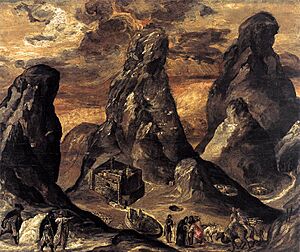Law of Moses facts for kids
The Law of Moses, also known as the Mosaic Law, is a collection of rules and teachings that, according to Abrahamic religions, God gave to Moses. These laws are mainly found in the Torah, which are the first five books of the Hebrew Bible. These books tell the story of the Israelites and provide guidance for how they should live and worship God.

Contents
What is the Law of Moses?
The term "Law of Moses" comes from the Hebrew phrase Torat Moshe, which means "Teachings of Moses." You can find this term in ancient texts like the Book of Joshua. The word "Torah" itself means "law" or "instruction" and refers to the first five books of the Hebrew Bible: Genesis, Exodus, Leviticus, Numbers, and Deuteronomy. These books are also sometimes called the "Pentateuch," which means "five books" in Greek.
For many people, the Torah is not just a set of rules. It's a guide for life, containing stories, history, and instructions on how to live in a way that honors God.
Laws from Ancient Times
Long ago, many ancient societies had their own sets of laws to keep order. For example, the Code of Hammurabi from ancient Babylonia had rules about contracts and property. The Law of Moses shared some similarities with these other ancient laws. One famous idea, "eye for an eye" (meaning punishment should fit the crime), appeared in different forms in various ancient legal systems. There were also similar rules about things like what happens if an ox harms a person.
However, the Law of Moses was special because it taught that breaking a rule was not just an offense against other people or society. It was also seen as an offense against God. In ancient Israel, before there were kings, God was considered the ultimate ruler. This system is called a theocracy. Other ancient kingdoms usually had a human king who made the final decisions in legal matters.
Another interesting part of the Law of Moses was the idea of a Sabbatical Year. This was a special year when the land was left to rest, and debts were sometimes forgiven, helping those who were poor. This idea also had roots in older traditions that aimed to help people in need.
Moses and the Hebrew Bible
According to the Hebrew Bible, Moses was a very important leader. He guided the Israelites out of Egypt to freedom. Traditionally, people believed Moses wrote the first five books of the Hebrew Bible. However, many modern scholars now think that these books were written by several different authors over a long period.
Regardless of who wrote them, the laws linked to Moses, especially those in the books of Leviticus and Deuteronomy, became the most important rules for the Israelites. These laws were considered more important than any king's commands. The Levites, who were a group of priests, were responsible for protecting and explaining these laws to the people.
The Bible mentions Moses writing down God's words in several places. For instance, in the Book of Deuteronomy, it says Moses told the people to "Take this book of the law, and put it by the side of the Ark of the Covenant of the Lord." This shows how central these written laws were to their faith and community.
What Kinds of Laws Were There?
The Law of Moses covered many different parts of life. These rules are found throughout the books of Exodus, Leviticus, Numbers, and Deuteronomy. Here are some of the main types of laws:
- The Ten Commandments: These are ten fundamental rules for living, given by God to Moses on Mount Sinai.
- Moral Rules: These laws guided how people should treat each other, focusing on honesty, fairness, and respect for others' lives and relationships.
- Social Rules: These covered everyday life, including rules about property, how families should work, and how to handle disagreements.
- Food Rules: These laws explained which foods were considered "clean" or "unclean" and how to prepare and store food properly.
- Purity Rules: These were rules about cleanliness and health, helping the community stay healthy and ready for worship.
- Special Feasts and Holidays: The Law included instructions for celebrating important religious festivals throughout the year, like Passover and the Day of Atonement.
- Offerings and Devotion: These were guidelines for different ways people could show their devotion to God, often through various types of offerings or gifts.
- Rules for Priests: Specific instructions were given for the priests and the High Priest, outlining their duties and how they should serve God and the community.
- Building the Tabernacle and Temple: Detailed plans were provided for constructing the Tabernacle, a special portable tent for worship, and later for the Temple in Jerusalem. These places housed important items like the Ark of the Covenant, which contained the tablets of the law.
- Guidance for Future Leaders: The Law also included advice and rules for when the Israelites would eventually have their own kings.

